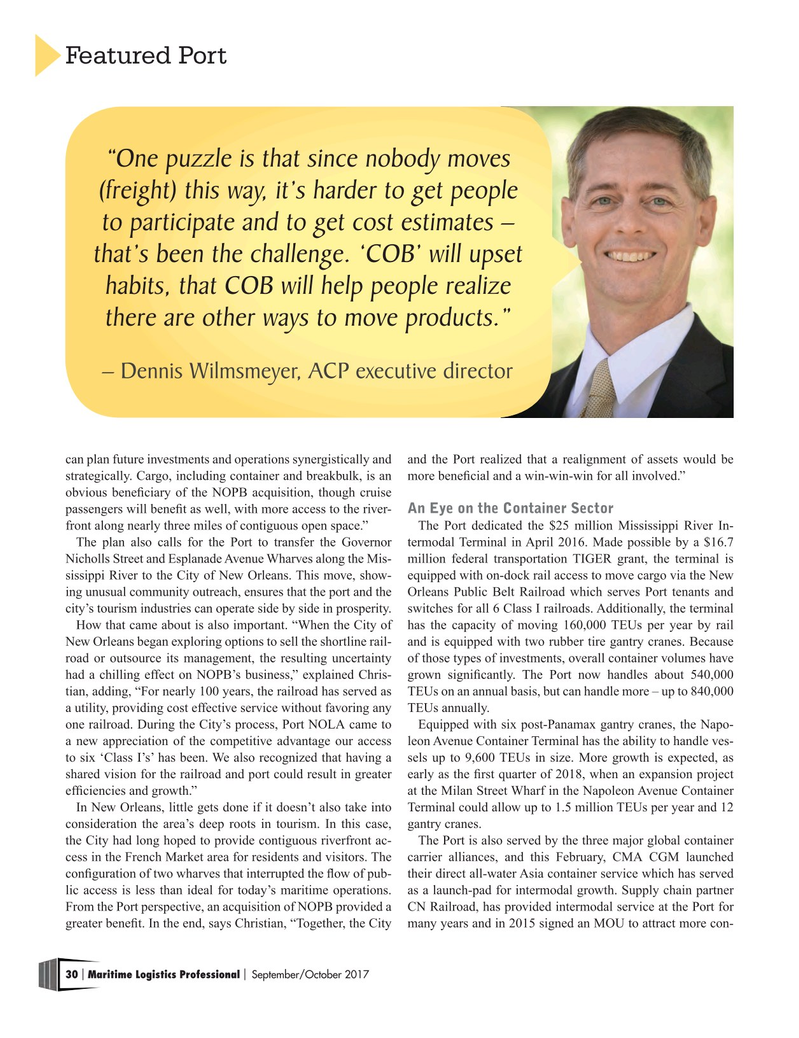
Page 30: of Maritime Logistics Professional Magazine (Sep/Oct 2017)
CONTAINER PORTS
Read this page in Pdf, Flash or Html5 edition of Sep/Oct 2017 Maritime Logistics Professional Magazine
Featured Port “One puzzle is that since nobody moves (freight) this way, it’s harder to get people to participate and to get cost estimates – that’s been the challenge. ‘COB’ will upset habits, that COB will help people realize there are other ways to move products.” – Dennis Wilmsmeyer, ACP executive director can plan future investments and operations synergistically and and the Port realized that a realignment of assets would be strategically. Cargo, including container and breakbulk, is an more benefcial and a win-win-win for all involved.” obvious benefciary of the NOPB acquisition, though cruise passengers will beneft as well, with more access to the river- An Eye on the Container Sector front along nearly three miles of contiguous open space.” The Port dedicated the $25 million Mississippi River In-
The plan also calls for the Port to transfer the Governor termodal Terminal in April 2016. Made possible by a $16.7
Nicholls Street and Esplanade Avenue Wharves along the Mis- million federal transportation TIGER grant, the terminal is sissippi River to the City of New Orleans. This move, show- equipped with on-dock rail access to move cargo via the New ing unusual community outreach, ensures that the port and the Orleans Public Belt Railroad which serves Port tenants and city’s tourism industries can operate side by side in prosperity. switches for all 6 Class I railroads. Additionally, the terminal
How that came about is also important. “When the City of has the capacity of moving 160,000 TEUs per year by rail
New Orleans began exploring options to sell the shortline rail- and is equipped with two rubber tire gantry cranes. Because road or outsource its management, the resulting uncertainty of those types of investments, overall container volumes have had a chilling effect on NOPB’s business,” explained Chris- grown signifcantly. The Port now handles about 540,000 tian, adding, “For nearly 100 years, the railroad has served as TEUs on an annual basis, but can handle more – up to 840,000 a utility, providing cost effective service without favoring any TEUs annually.
one railroad. During the City’s process, Port NOLA came to Equipped with six post-Panamax gantry cranes, the Napo- a new appreciation of the competitive advantage our access leon Avenue Container Terminal has the ability to handle ves- to six ‘Class I’s’ has been. We also recognized that having a sels up to 9,600 TEUs in size. More growth is expected, as shared vision for the railroad and port could result in greater early as the frst quarter of 2018, when an expansion project effciencies and growth.” at the Milan Street Wharf in the Napoleon Avenue Container
In New Orleans, little gets done if it doesn’t also take into Terminal could allow up to 1.5 million TEUs per year and 12 consideration the area’s deep roots in tourism. In this case, gantry cranes.
the City had long hoped to provide contiguous riverfront ac- The Port is also served by the three major global container cess in the French Market area for residents and visitors. The carrier alliances, and this February, CMA CGM launched confguration of two wharves that interrupted the fow of pub- their direct all-water Asia container service which has served lic access is less than ideal for today’s maritime operations. as a launch-pad for intermodal growth. Supply chain partner
From the Port perspective, an acquisition of NOPB provided a CN Railroad, has provided intermodal service at the Port for greater beneft. In the end, says Christian, “Together, the City many years and in 2015 signed an MOU to attract more con- 30 Maritime Logistics Professional September/October 2017 | |

 29
29

 31
31
